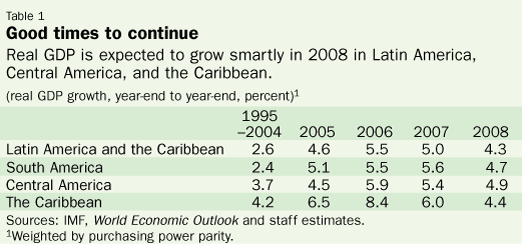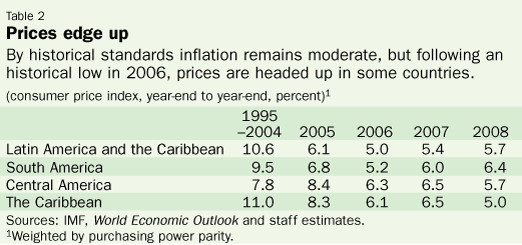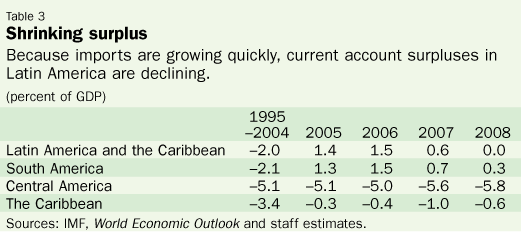
Typical street scene in Santa Ana, El Salvador. (Photo: iStock)
IMF Survey: Latin American Growth to Continue Strong
November 9, 2007
- Region poised for fifth year of expansion
- Fiscal, current account surpluses are shrinking
- U.S. economy, financial markets are big questions
Latin America is poised for what could be its fifth consecutive year of strong economic growth in 2008.

Bronze foundry in Latin America, where solid policies are moving region toward best growth performance in decades, IMF says (photo: Daniel Garcia/AFP)
REGIONAL ECONOMIC OUTLOOK
But inflation, after falling to an historical low for the region in 2006, is edging up in several countries, the IMF said in its Regional Economic Outlook for the Western Hemisphere, which it unveiled in Sao Paulo, Brazil, on November 9.
So far, Latin America and the Caribbean seem to have weathered the fallout from the global financial turbulence that has its roots in the decline in the U.S. housing markets. But the problems in financial markets, which began last summer, have "significantly increased downward risks" for the region, the IMF said in its semiannual report. The main sources of that risk include weaker external growth, with its attendant impact on commodity prices, and possible further tightening in U.S. and world credit markets.
Beyond the external conditions, the IMF said, the "sustainability" of the Latin American expansion will also depend on preserving "the strength of underlying fiscal positions" in the countries and "the resilience of domestic financial sectors." The report noted that strong fiscal and external current account surpluses are beginning to shrink as public spending accelerates and imports rise.
Solid policies
Still, the overall message is "positive," said Anoop Singh, Director of the Western Hemisphere Department. "This is a recovery and a growth phase that is different from its predecessors" and is "not going to be terminated, we think, as prematurely as earlier ones" because of solid fiscal and monetary policies that make the region more resilient than it was in the past to changes in the external environment, Singh said at a briefing in Washington prior to the report's release.
Overall, the IMF predicts that growth in the region will be about 5 percent in 2007, moderating to about 4¼ percent in 2008. The decrease projected for next year reflects a less favorable external environment, and capacity constraints in some countries.
Still, if developments turn out as expected, 2008 would be the fifth year in a row that growth has exceeded 4 percent, Latin America's best performance in decades (see Table 1).

While Latin America is resilient enough to deal with the current global financial turbulence and some slowdown in U.S. growth, it would be more seriously affected were there to be a pronounced slowdown in the industrialized countries, especially the United States, and a credit crunch in financial markets. Were that downside scenario to unfold in coming months, with a further weakening of commodity prices, growth would slow significantly in Latin America's economies, perhaps to as low as 2½ percent overall in 2008, nearly 2 percentage points below the baseline projection.
Energy shortages
In a few countries, "energy shortages could also create risks to the growth outlook" and many nations are facing food price shocks that heighten inflation risks. Overall, inflation in Latin America and the Caribbean is expected to rise from 5 percent last year to 5.4 percent this year and 5.7 percent next year (see Table 2).

The rising inflation reflects both the worldwide increase in food prices and growing aggregate demand as a result of the economic expansion. The increase in imports is one indication that demand is growing faster than production capacity. So is a leveling off in the decline of the unemployment rate, which "may now largely reflect structural bottlenecks," the IMF said. Overall, food prices are increasing almost 4 percentage points faster than the published overall inflation, according to the IMF report.
The price picture also has implications for monetary policy. Authorities will have to balance the risks of inflation induced by capacity constraints and food prices against the possibility of a more significant slowdown in the United States, which would lead to reduced growth.
But the region has so far sidestepped most of the financial turmoil that began in U.S. markets and spread. Latin American equity prices fell, currencies depreciated, and bond prices declined in the early days of the turbulence that began mid-summer—in part, perhaps, because investors in hard-hit mortgage backed securities sold other investments, including those in emerging markets, to cover their losses in the mortgage market. But equities and bond prices have since mainly recovered and currencies appreciated.
Imports growing
The IMF report also projected that both the current account surpluses and the fiscal surpluses, which had been a source of stability, will shrink this year and next (see Table 3).

Imports are growing faster than exports and commodity prices have stabilized (although at high levels), so that export earnings are no longer rising so rapidly. As a result, "the trend toward weaker current accounts is shared by most countries in the region," the IMF said.
Meanwhile fiscal surpluses, which peaked in 2006, are projected to decline about 2 percent this year and 1 ¾ percent next, as revenues, heavily driven by commodity prices, slow and government expenditures continue to grow. "Unless the pace of spending growth is curbed, many countries in the region are likely to return to structural deficits in 2008," the IMF report warned.
The ongoing expansion has brought with it significant declines in both poverty and inequality, among the two most pressing long-term problems facing Latin America. Continuing reductions in both are linked to sustaining a rising trend in growth and productive investment— two areas in which, despite improvement, the region lags other emerging market economies. The regional outlook said that "to tackle persistent inequality and high poverty," better targeting of social spending is essential, and the region is developing effective models for this purpose in their growing experience with conditional cash transfer programs.


